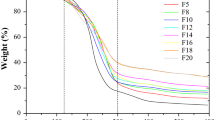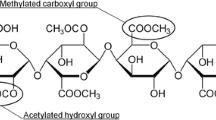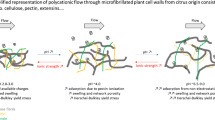Abstract
The hydration and mechanical properties of citrus pectin films were examined in conditions relevant to those in the plant cell wall. The pectins used for this study varied in the degree of esterification (DE) (high or low) and charge distribution on the backbone (random or block). The hydration of the films was controlled in an osmotic pressure experiment using polyethylene glycol solutions (PEG 20000). Hysteresis tests at constant deformation rate (stress vs deformation) were used for investigating the mechanical behaviour of films. Mechanical and hydration properties of pectin films were examined as a function of charge density, charge density distribution and counterion environment—K+, Ca2+, Mg2+. Swelling decreased with increasing counterion concentration. The effect is stronger in the case of Ca2+ and Mg2+ for low esterified pectins and therefore crosslinks from divalent ions could be assumed. The crosslink effect is confirmed in mechanical experiments where an increase in the film tensile modulus is observed with increasing counterion concentration. It is shown for the first time that in case of highly concentrated pectin solutions Mg2+ cations also act as a crosslinker for pectin macromolecules.



Similar content being viewed by others
References
Cosgrove DJ (1999) Enzymes and other agents that enhance cell wall extensibility. Annu Rev Plant Physiol Plant Mol Biol 50:391–417
Schols HA, Voragen AGJ (1994) Hairy (ramified) regions of pectins. 4. Occurrence of pectic hairy regions in various plant-cell wall materials and their degradability by rhamnogalacturonase. Carbohydr Res 256:83–95
Schols HA, Voragen AGJ (1994) Hairy (ramified) regions of pectins. 5. Isolation and characterization of rhamnogalacturonan oligomers, liberated during degradation of pectic hairy regions by rhamnogalacturonase. Carbohydr Res 256:97–111
Taylor AJ (1982) Intramolecular distribution of carboxyl groups in low methoxyl pectins—a review. Carbohydr Polym 2(1):9–17
Thibault J-F, Rinaudo M (1985) Interactions of monovalent and divalent counterions with alkali-deesterified and enzyme-deesterified pectins in salt-free solutions. Biopolymers 24(11):2131–2143
Macdougall AJ et al (1996) Calcium gelation of pectic polysaccharides isolated from unripe tomato fruit. Carbohydr Res 923:235–249
Bystricky S et al (1990) Interaction of alginates and pectins with cationic polypeptides. Carbohydr Polym 13:283–294
Thibault JF, Rinaudo M (1986) Chain association of pectin molecules during calcium-induced gelation. Biopolymers 25(3):455–468
Malovikova A, Rinaudo M, Milas M (1994) Comparative interactions of magnesium and calcium counterions with polygalacturonic acid. Biopolymers 34:1059–1064
Flory PJ (1953) Principles of polymer chemistry. Cornell University Press, London, pp 464–469 (see also pp576–581)
Ryden P et al (2000) Hydration of pectic polysaccharides. Biopolymers 154(6):398–405
Basic А, Harris PJ, Stone BA (1988) Structure and function of plant cell walls. In: Preiss J (ed) The biochemistry of plants, a comprehensive treatise, vol 14. Academic, London, pp 297–369
Macdougall AJ et al (1995) Nonaqueous fractionation to assess the ionic composition of the apoplast during fruit ripening. Plant Physiol 108:1679–1689
Almeida DP et al (1999) Apoplastic pH and inorganic ion levels in tomato fruit: a potential means for regulation of cell wall metabolism during ripening. Physiol Plant 105:506–512
Tomos AD et al (1999) The pressure probe: a versatile tool in plant cell physiology. Annu Rev Plant Physiol Plant Mol Biol 50:447–472
Needs PW et al (2001) Specific degradation of pectins via a carbodiimide-mediated Lossen rearrangement of methyl esterified galacturonic acid residues. Carbohydr Res 333:47–58
Parsegian VA et al (1995) Macromolecules and water probing with osmotic stress. Methods Enzymol 259:43–95
Marudova MG et al (2004) Physicochemical studies of pectin/poly-L-lysine gelation. Carbohydr Res 339(2):209–216
Zsivanovits G et al (2004) Material properties of concentrated pectin networks. Carbohydr Res 339(7):1317–1322
Manning GS (1996) The critical onset of counterion condensation: a survey of its experimental and theoretical basis. Berenges Phys Chem 100:923–928
Kohn R (1975) Ion binding on polyuronates—alginate and pectin. Pure Appl Chem 42:371–399
Oakenfull DG (1984) A method for using measurements of shear modulus to estimate the size and thermodynamic stability of junction zones in noncovalent crosslinked gels. J Food Sci 49(4):1103–1104
Horkay F et al (2000) Osmotic swelling of polyacrilate hydrogels in physiological salt solutions. Biomacromolecule 1:84–90
Acknowledgements
The authors thank the BBSRC core strategic grant for financial support; the EC Commission for the award of a Marie Curie fellowship to G.Zs. and M.M. (Contract Number QLK-1999-50512); CP Kelco for providing the pectin samples.
Author information
Authors and Affiliations
Corresponding author
Rights and permissions
About this article
Cite this article
Zsivánovits, G., Marudova, M. & Ring, S. Influence of mechanical properties of pectin films on charge density and charge density distribution in pectin macromolecule. Colloid Polym Sci 284, 301–308 (2005). https://doi.org/10.1007/s00396-005-1378-2
Received:
Accepted:
Published:
Issue Date:
DOI: https://doi.org/10.1007/s00396-005-1378-2




